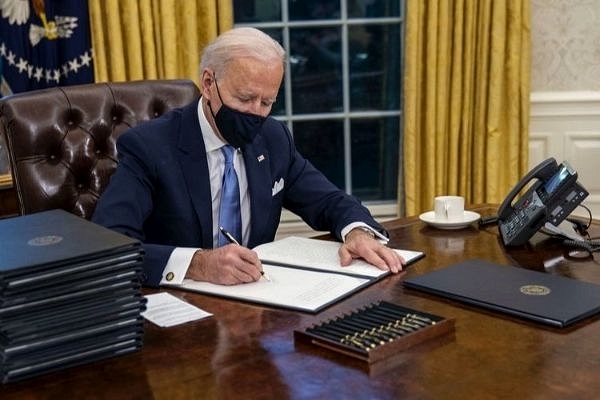Context
Why The CHIPS And Science Act Matters To The US

United States President Joe Biden (Source: Twitter)
The US House of Representatives passed the $280 billion CHIPS and Science Act in the last week of July to give a boost to semiconductor manufacturing in the country.
The legislation: Known as CHIPS or ‘Creating Helpful Incentives To Produce Semiconductors’, the Act makes provisions worth billions for its objectives.
It comes with $52 billion for the semiconductor industry in America.
The funding subsidises companies building fabs or production plants within the US.
It also brings $200 billion in scientific research in AI, quantum computing, and other relevant technologies.
It sets aside billions of dollars for building a semiconductor ecosystem with elaborate R&D facilities and a thriving workforce.
Companies building fabs will also be eligible for tax credits.
Political support: In a rare display of bipartisanship, the bill received support across the aisle.
In February 2021, US President Joe Biden signed an executive order directing the administration to address the worrying shortfall in semiconductor production.
When the bill was put to vote, the Senate voted 64-33 in favour of the bill, and the House passed it with 243 votes against 187.
The Act also had the backing of the US Chambers of Commerce and the National Association of Manufacturers.
Covid-19 exposed the vulnerabilities of the US to semiconductor supply chains, most of which are deeply embedded in Asia.
Despite being the global leader in semiconductor design and R&D, the US outsourced the majority of chip manufacturing to Asia.
While the US accounts for 47 per cent of the total semiconductor sales worldwide, it accounts for only 12 per cent of the global production.
The impact of this skew in numbers was in play during the pandemic.
Given the shortage in chips, automakers in several parts of the US were forced to cut jobs and worker hours.
Consequently, General Motors was forced to halt production at its three North American plants and Ford was staring at a 20 per cent drop in short-term output.
The chip shortage, as per a report, resulted in the auto industry's $210 billion revenue hole.
The challenge for the US is in chip design innovation, which depends on the most advanced fabrication technologies available.
The most advanced semiconductor fabrication technologies and facilities are in the 5 nm category.
The smaller the nanometer reading, the more transistors per square millimetre and the more advanced is the fabrication process.
Geopolitical consideration: The CHIPS and Science Act must also be viewed in the context of China’s greater aggression against Taiwan.
Taiwan's TSMC holds more than 50 per cent market share in the global semiconductor industry.
In May 2020, TSMC announced that it was building a production plant in Arizona, US.
Japan also approached TSMC to hedge its bets against the semiconductor supply chain, approving an investment of $6.8 billion.
US industry on board: They are backing the legislation for various reasons, including the threat of intellectual property theft in China.
Testifying before the Senate Committee on Commerce, Science and Transportation last week, various industry leaders stressed the importance of the CHIPS act, citing how subsidies in China, Taiwan, and South Korea, together responsible for 80 per cent of the semiconductor production, had aided the sector there.
Intel CEO spoke about the importance of the Chinese market from a competition perspective also.
Chinese displeasure over the Act was palpable.
Chinese foreign ministry spokesperson Zhao Lijian in a press briefing last week said the Act could derail technological cooperation between China and the US.
A report says the Act is purportedly aimed at bolstering the competitive edge of the American sci-tech and chip industries, while certain provisions restrain normal sci-tech cooperation between the two countries and, thus, the Chinese are against it.
Zhao added that the cooperation between the two countries serves the interests of both and promotes humanity's progress, but decoupling will only hurt.
He further stated that no restriction or suppression will hinder China’s industrial progress.
European CHIPS Act: Europe has around 10 per cent share in global semiconductor production, thus making them vulnerable to possible crises.
Earlier this year, the European Commission announced its plan to allocate 11 billion euros from public funds to study, design, and produce semiconductors.
By 2030, the Commission wants to mobilise 43 billion euros in public and private investment to further its semiconductor ecosystem and to increase its global production share to 20 per cent.
Bottom line: Covering investments in semiconductors, wireless supply chain innovations, biological and environmental research, advanced scientific computing, fusion energy research, high energy physics, nuclear physics, accelerator R&D, AI, and other fields, the Act aims to reverse American technological supremacy lost to China and other countries in recent years.
For Biden, the CHIPS legislation is a rare economic and political victory.
Support Swarajya's 50 Ground Reports Project & Sponsor A Story
Every general election Swarajya does a 50 ground reports project.
Aimed only at serious readers and those who appreciate the nuances of political undercurrents, the project provides a sense of India's electoral landscape. As you know, these reports are produced after considerable investment of travel, time and effort on the ground.
This time too we've kicked off the project in style and have covered over 30 constituencies already. If you're someone who appreciates such work and have enjoyed our coverage please consider sponsoring a ground report for just Rs 2999 to Rs 19,999 - it goes a long way in helping us produce more quality reportage.
You can also back this project by becoming a subscriber for as little as Rs 999 - so do click on this links and choose a plan that suits you and back us.
Click below to contribute.
Latest